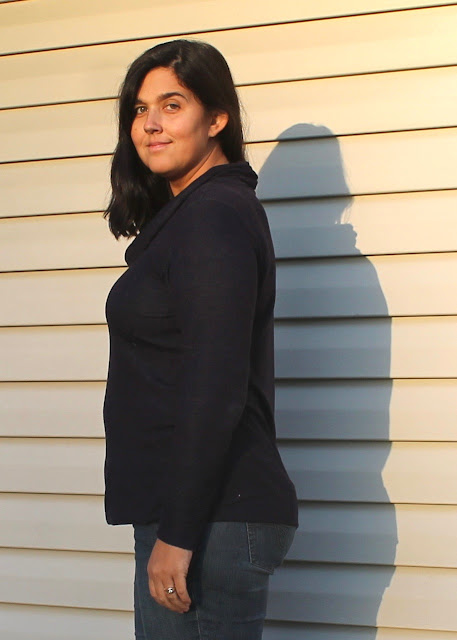I finally made an
Appleton dress!
As always, it took me while to hop aboard this train. When it comes to pricier patterns (i.e. anything other than Big 4 on sale at Joann's), I am really slow to purchase. I like to see a lot of examples of the garment made up before I plunk down my money. The Appleton has long seemed like a no-brainer because 90% of the versions I have seen look stunning on their makers. I acquired both pattern and fabric last summer with the intent of making this dress, but only just got around to it in January.
I used an ITY knit purchased from FabricMart for about $3.60/yard. The fabric is really nice to work with, and the dress sewed up in a few hours on my serger and coverstitch machine.
I didn't muslin (this is my muslin), and I sewed a 14E/F cup graded to between a 14 and 16 starting at the waist down through the hem (I'm 42.5-35-45). It is a pretty good start, but I think it needs some tweaks. I was actually super disappointed when I first tried it on, to see that a good 1/2" of the bridge of my bra was showing at the overlap. I thought of all the stunning Appletons I had seen in blogland and how none of them had any bra peekaboo going on, and I felt cheated.
But that was stupid. I've since had a good hard look at the topography on my upper half, and I've come to the conclusion that, if I want the wrap to go under my bust (and I do), then the overlap is necessarily going to be pretty low. I might be able to gain that 1/2" by tweaking with the angle of the slope on the bodice and the neckband join, but that's a lot of work when I can just safety pin the dress together. Which is what I did in these photos - without the safety pin the overlap is about an inch lower.
On Instagram, Jenny advised that going up a cup size would provide more coverage, so I am going to try that for the next one, but I'm not going to sweat it if I have to resort to the safety pin. I think a low cut is simply the nature of a wrap dress for a busty girl.
The print makes it hard to see, but there are some folds in the fabric just above my bust, radiating from the armpit. I did some research and found a suggestion to shorten the armscye. I also found suggestions to FBA/increase cup room. Going up a cup size is easier so I'm going to try that first before messing with the armscye. I do plan to make this up in a solid, and the wrinkles will be a lot more noticeable then, so hopefully I can figure it out.
Another item of concern was the amount of overlap at the skirt. When I first tried on the dress, it seemed like it was just begging for a wardrobe malfunction. But while shooting these pictures, I tried my hardest to get the skirt to separate ...
... by walking determinedly forward ...
... by standing weirdly wide ...
... and leaning awkwardly to the side.
I stopped short of high kicks; though the Appleton kept her ladylike composure during my initial antics, I figured she wouldn't survive martial arts. A good strong wind could pose a problem, as well.
She only plays peekaboo when I sit, though it's actually ok as long as I keep my knees together and don't cross my legs. I think I will be able to fix this issue by cutting both wrap fronts the same next time (the pattern has you trim the front piece to be narrower than the back piece).
I also think I need a little more room in my upper waist . While the dress looks fine from the front, from the back I have a little of the mattress-tied-in-the-middle look going on. My husband says the pattern distracts from it and I think he's probably right, but it still bugs me. Going up a cup size on the next one should help, but I think I might grade the back piece out a bit more from the bottom of the armscye to the waist, to help it skim over the excess flesh back there. And I want to try the dress with a size 16 sleeve, as these sleeves are a little too tight for me.
Finally, I will add length to the hem. I am 5'8" and the pattern is drafted for 5'6". The dress was the perfect length without hemming, so I didn't hem it (yay knits!). I would prefer a proper hem, though, so I added an inch to my pattern pieces for next time.
All quibbles aside, the fit out of the envelope was not bad at all. The dress is totally wearable; even more so with Spanx (which I am not wearing in these photos). Not having to do an FBA was, frankly, AMAZING. I can, and do, perform FBAs all the time, but it considerably lengthens the drafting phase of sewing, and I suspect I'm not alone in really not enjoying that part of the process.
I also really appreciated how well all the pattern pieces came together - the notches lined up, the angles lined up, and the instructions were good. I'm a happy camper.































